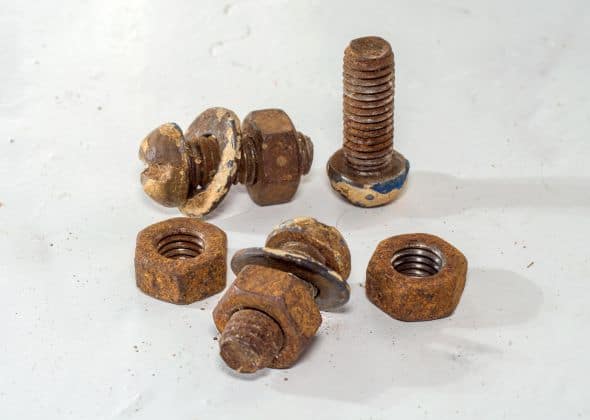Simple tasks like removing your car’s license plate screws can become frustrating if they won’t come out. This becomes even more annoying when you don’t know how to get them out but you need to replace the license plate. Don’t worry, this article will help you understand why your license plate screws won’t come out and also give methods to remove them.
The main reasons why your license plate screws won’t come out is because they are rusted, they are locked in too tightly, or they are stripped. There are different methods to deal with these situations, like penetrating oil, vinegar, heat, a rotary tool, etc.
Table of Contents
5 Ways To Solve License Plate Screws Won’t Come Out

#1. With Vinegar Or Penetrating Oil
Method 1. Spray penetrating oil on the screws:
This will make it easier to unscrew them. Let the oil sit on for 15 minutes or so before you try unscrewing the screws. Generally, penetrating oil comes in a spray can with a nozzle, so you can get the oil on the target screws without getting the rest of the area dirty. Also, try spraying some penetrating oil on the behind of the license plate as well to loosen the screws even more.
Method 2. Using Vinegar:
Vinegar has multiple uses and can help you loosen your license plate screws (especially if they are rusted). It is great at removing rust and so, all you need to do is pour some white vinegar on the rusted screws. You could also soak a cloth piece in vinegar and rub it on the screws.
Wait for some time until some rust gets off of the license plate screws. Then, try unscrewing them with a screwdriver. You can also scrub off the rust with a steel brush while loosening the screws and pour more vinegar (if required).
Method 3. Impact Wrench
Rusted screws might not be that easy to remove and sometimes all you need is force. So, you could use an impact wrench that can deliver high rotational torque. This method would work better if you have oiled these screws with penetrating oil beforehand.
Note: You should consider wearing safety glasses to protect yourself from harm since using an impact wrench can break the rusted license plate screws. Hence, if you don’t want to break your screws, consider using an impact wrench as your last resort.
#2. Via Heat
If your license plate screws are really stubborn and won’t get off easily, then using heat will remove them in no time. Heating the screws expands the metal around them and then, you can cool them to compress and take them out.
Tools Required:
- Water-based degreaser or detergent
- Screwdriver
- Gas torch
- Cold water
- Fire extinguisher and leather gloves (for safety)
Step 1. If the screws have rust on them, use some water-based degreaser or detergents to loosen them. Don’t use penetrating oil or other chemicals because they are flammable. If you don’t want to buy a degreaser, you can make a DIY one at home using baking soda or vinegar.
Step 2. Take a gas torch and start heating the screws until smoke comes out from it. You need to take the flame away when the screw starts turning red. Make sure that you don’t overheat the screw.
Step 3. Now, spray the screws using cold water. This would contract them quickly. You need to repeat the heating and cooling process about 3 to 4 times until the screws get loose.
Step 4. Once, the screws loosen up, grab a screwdriver and remove the screws from the license plate.
Note: You should always keep a fire extinguisher nearby while trying out this method. Also, follow complete safety measures to stay clear of accidents. Wear safety leather gloves and wipe off flammable chemicals to eliminate the chances of starting a fire.

#3. With A Rotary Tool (For Stripped Screws)
If the license plate screws are stripped, you won’t have a groove to insert the screwdriver and loosen them. In this case, the procedure given below will help you out.
Note: Consider wearing protective equipment like gloves and goggles. These are necessary for protection while using a power tool.
Tools Required:
- Rotary tool
- Penetrating oil
- Screwdriver
- Protective goggles and leather gloves (for protection)
Step 1. Use a rotary tool with the right kind of attachment suitable for making a groove the size of the head of a screwdriver.
Step 2. Now, you can use the methods mentioned above like penetrating oil, degreaser, etc. to loosen the screws.
Step 3. Once you have loosened the screws, you can remove them from your license plate. Add more lubricant if needed. Also, if the groove is narrow for your screwdriver, make use of the rotary tool to expand.
#4. Use A Flathead Screwdriver and Vice Grips (If the screws keep turning but won’t come out)
If the screws keep turning and won’t get off, then you need to go to the backside of the screws and reach out to the screw ends.
Tools Required:
- Vice grips or pliers
- Screwdriver
- Penetrating oil spray
Step 1. Open the liftgate to check out the rear side of the license plate and screw endings.
Step 2. If a plate/panel is covering the rear side of the screws and their latch assembly, just pull it with your hand and it will pop right out.
Step 3. Now, you will be able to see the rear gate latch assembly and the back ends of the screws.
Step 4. Hold the screw ends from the inside of the liftgate with vice grips or pliers and turn the screws on the outside with a screwdriver.
You can check out our article for the Top 5 Best Paints for Rusty Frames, which will color your car and protect it from rust.
#5. Via Rubber Band
A rubber band can be a surprisingly effective tool for removing stuck license plate screws. Place a wide rubber band over the screw head, pressing it firmly to create a good grip. Then, position the screwdriver on top of the rubber band and turn it counterclockwise. The rubber band should grip the screw, allowing you to unscrew it with ease.
next time when you attach number plate to your vehicle, remember to apply bedliners to keep rust away.
Prevent License Plate Screws From Jamming in the Future
To avoid jammed license plate screws in the future, consider the following tips:
- Use stainless steel or rust-resistant screws: They’re less likely to corrode and get stuck in place.
- Apply an anti-seize compound: Before installing screws, apply a small amount of anti-seize compound to the threads. This helps prevent corrosion and makes future removal easier.
- Keep the threads clean: Ensure the threads on both the screws and mounting holes are clean and free of debris before installation.
- Avoid over tightening: Overtightening can strip the threads and make screws difficult to remove. Tighten them securely but not excessively.
- Regular maintenance: Periodically inspect and clean the screws and mounting area to prevent rust and corrosion buildup.
By following these solutions and preventative tips, you can successfully remove stubborn license plate screws and avoid the issue from occurring in the future.
FAQs
Here below I’ve listed the most frequently asked questions about license plate screws that won’t come out: how to remove them?
Do screws always turn left to loosen?
Generally, screws follow the “righty-tighty, lefty-loosey” rule, meaning they turn left (counterclockwise) to loosen and right (clockwise) to tighten. However, some specialised screws, like reverse-threaded or left-handed screws, follow the opposite pattern.
How long should I let screws soak in vinegar?
Soaking screws in vinegar for at least 15-30 minutes should help remove rust and loosen them. For heavily rusted screws, you may need to let them soak for several hours or even overnight.
What is the fastest way to unscrew a rusted screw?
The fastest way to unscrew a rusted screw is to use a penetrating oil, like WD-40. Spray the oil on the screw, wait a few minutes for it to penetrate, and then try unscrewing it with a screwdriver or power tool.
Can you hammer out a stuck screw?
We don’t recommend hammering out a stuck screw, because it can damage the screw head or surrounding material. Instead, try using a penetrating oil, pliers, or a screw extractor to safely remove the stuck screw.
Wrapping Up
Now, you must have a clear picture of the reasons why your license plates won’t come out and ways to remove them. You can follow whichever method you want to as per your license plate screw problem. Make sure you maintain the safety measures mentioned above if you need to use any power tools. Also, you should consider replacing your rusted license plate screws with stainless steel license plate screws since they won’t catch rust.
